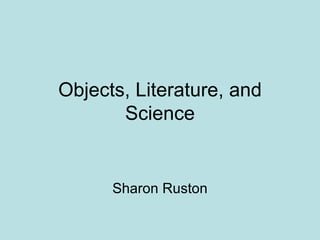Objects, Literature, and Science
- 1. Objects, Literature, and Science Sharon Ruston
- 2. ŌĆś The object of this work is to explain more minutely than has hitherto been done, the changes of structure arising from morbid actions in some of the most important parts of the human bodyŌĆÖ (M. Baillie, Morbid Anatomy, p. i). ŌĆś The subject in itself is extremely difficult, because morbid actions are going on in the minute parts of an animal body excluded from observation; but still the examination of morbid structure seems to be one of the most probable means of throwing light upon it.ŌĆÖ ( ibid, p. ii).
- 3. ╠²
- 4. ╠²
- 5. Joanna BaillieŌĆÖs ŌĆśIntroductory DiscourseŌĆÖ to a Series of Plays ŌĆśnothing has become so much an object of manŌĆÖs curiosity as man himselfŌĆÖ ŌĆśtracing [the] varieties of understanding and temper which constitute the characters of menŌĆÖ ŌĆśextraordinary situations of difficulty and distressŌĆÖ
- 6. It is not merely under the violent agitations of passion, that man so rouses and interests us; even the smallest indications of an unquiet mind, the restless eye, the muttering lip, the half-checked exclamation, and the hasty start, will set our attention as anxiously upon the watch, as the distant flashes of a gathering storm (BaillieŌĆÖs ŌĆśIntroductory DiscourseŌĆÖ)
- 7. General Questions How might we use objects in text-based research and what would be gained by doing so? How could you use objects in your own research?
- 8. Bibliography Baillie, Joanna, Plays on the Passions , ed. Peter Duthie (Ontario: Broadview, 2001) Baillie, Matthew, The Morbid Anatomy of Some of the Most Important Parts of the Body (London: J. Johnson, 1793). Burwick, Frederick, ŌĆśJoanna Baillie, Matthew Baillie, and the pathology of the passionsŌĆÖ, Joanna Baillie: Romantic Dramatist , ed. Thomas Crochunis (Routledge, 2004), pp. 48-69. Jordanova, Ludmilla, Defining Features: Scientific and Medical Portraits, 1660-2000 (London: Reaktion Books, 2000). McMillan, Dorothy, ŌĆśŌĆ£Dr BaillieŌĆØ, 1798: The Year of the Lyrical Ballads , ed. by Richard Cronin (Houndsmills: Macmillan, 1998), pp. 68-93. Myers, Victoria, ŌĆśJoanna Baillie and the Emergence of Medico-Legal DiscourseŌĆÖ, European Romantic Review , 18:3 (July 2007), pp. 339-359. Richardson, Alan, A Neural Theatre: Joanna BaillieŌĆÖs ŌĆ£Plays on the PassionsŌĆØ , Joanna Baillie: Romantic Dramatist , ed. Thomas Crochunis (Routledge, 2004), pp. 130-146. Stabler, Jane, Burke to Byron, Barbauld to Baillie, 1790-1830 (Houndsmills: Palgave, 2002)





![Joanna BaillieŌĆÖs ŌĆśIntroductory DiscourseŌĆÖ to a Series of Plays ŌĆśnothing has become so much an object of manŌĆÖs curiosity as man himselfŌĆÖ ŌĆśtracing [the] varieties of understanding and temper which constitute the characters of menŌĆÖ ŌĆśextraordinary situations of difficulty and distressŌĆÖ](https://image.slidesharecdn.com/sharonruston-100329084631-phpapp02/85/Objects-Literature-and-Science-5-320.jpg)


